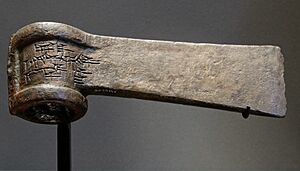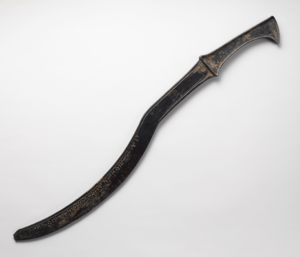Adad-nirari I facts for kids
Quick facts for kids Adad-nirari I |
|
|---|---|
| King of Assyria | |
| King of the Middle Assyrian Empire | |
| Reign | 31 regnal years 1305-1274 BC (MC) 1295-1263 BC (SC) |
| Predecessor | Arik-den-ili |
| Successor | Shalmaneser I |
| Issue | Shalmaneser I, Ibashi-ili |
| Father | Arik-den-ili |
Adad-nārārī I was a powerful king of Assyria during the Middle Assyrian Empire. His name means "Adad (is) my helper." He ruled for about 31 years, from around 1305 to 1274 BC. Adad-nārārī I is one of the first Assyrian kings whose story we know a lot about, thanks to detailed records from his time. He won many important battles that made Assyria much stronger. He was the son of King Arik-den-ili.
Contents
Early Victories

King Adad-nārārī I was very proud of his military wins. He said he defeated the strong armies of the Kassites (who lived in Babylonia to the south). He also beat the Qutu, Lullumu, and Shubaru tribes. He called himself the "pacifier of all enemies."
His victory over the Kassite king, Nazi-Maruttash, was very important. His father had struggled against the Kassites, so this win was a big deal. The battle happened near a town called Kār Ištar. Adad-nārārī's army attacked the Kassite camp like a huge flood. They took many treasures and the Kassite king's royal flag. This victory helped Assyria gain more land to the south.
After this defeat, the next Kassite king, Kadashman-Turgu, wanted peace. He made a treaty with Adad-nārārī, which showed Assyria's growing power.
Dealing with Other Empires
With the Kassites under control, the Assyrians focused on the Mitanni kingdom. The Mitanni were a vassal state of the Hittites, meaning they were protected by them. However, the Hittite king at the time, Mursili III, was less involved in international affairs. This might have made the Mitanni king, Shattuara I, think he could be more independent.
Adad-nārārī said that Shattuara attacked first. But the Assyrians defeated Shattuara and captured him. Shattuara was taken to Aššur and forced to promise loyalty to Assyria. He had to pay regular tribute for the rest of his rule. The Hittites did not step in to help him.
After these big wins, Adad-nārārī called himself šar kiššati, meaning "king of the universe." This was a title used by very powerful kings. He even wrote to the Hittite king, Mursili III, as an equal, calling him "brother." Mursili III was not happy about this. He wrote back, saying:
So you've become a "Great King," have you? But why do you still continue to speak about "brotherhood"?... For what reason should I call you "brother"?…Were you and I born of the same mother? My grandfather and my father did not call the King of Assyria "brother," so you should not keep writing to me about "Great King-ship." It displeases me.
Later, when Hattusili III became the Hittite king, Assyria had already taken over the Mitanni lands. Hattušili III even asked Adad-nārārī to help stop attacks from a town called Turira against Carchemish, which was a Hittite ally.
Hattušili also complained that Adad-nārārī did not send him gifts when he became king. This was a custom among kings. He also mentioned Adad-nārārī's request for iron:
Regarding the good iron you wrote about – good iron is not available in my armory. It is a bad time for making iron. They will make good iron, but they have not yet finished it. When they finish it, I will send it to you. For now, I have sent you a dagger blade of iron.
Conflict with the Mitanni (Hanigalbat) started again when Shattuara's son, Wasashatta, rebelled. He tried to get help from the Hittites. Adad-nārārī later said the Hittites took Wasashatta's gifts but did not help him. Adad-nārārī attacked, destroying many cities like Taite. He even spread salt-like materials over the land to make it unusable.
Finally, Wasashatta was captured at Irridu. He and his family were taken to Aššur and disappeared from history. Adad-nārārī took over the Mitanni kingdom completely. He appointed an Assyrian governor to rule the region.
How He Ruled
Adad-nārārī I might have made Wasashatta's old capital, Taida, the new center for Assyrian rule in that area. He said he rebuilt the palace there. He also restored many buildings in the city of Assur. These included the Step Gate of the temple of the god Ashur, parts of the city walls, and the quay along the Tigris river. He also worked on the temple of Ishtar and the storehouses of the gate of An and Adad.
His reign lasted for 31 years. We know about some of the officials who served him. One important official was Bābu-aḫa-iddina. He was a high-ranking officer who also served Adad-nārārī's sons. Many of his personal records were found in a tomb in Assur.

You can see a bronze sword that belonged to Adad-nārārī I in the Metropolitan Museum of Art today.
The Adad-nārārī Epic
There is an ancient story, or epic, about Adad-nārārī. It tells about his conflict with the Babylonian king Nazi-Maruttash. The story talks about the challenges his father faced. It also describes Adad-nārārī asking the god Šamaš for help before his big battle with the Kassite king.
New Discoveries

In 2018, archaeologists found inscriptions at Qasr Shemamok. These inscriptions were on brick molds. They talk about the celebration of building a palace by King Adad-nārārī I in a city called Kilizu.
See Also
- Kings of Assyria
- Middle Assyrian Empire

